Current Image of Research Exhibit
The 2022 Image of Research submissions were evaluated by a committee of jurors. Many thanks to this year’s jurors, Mr. Cecil McDonald, Jr. and Ms. Kandace Rusnack. Cecil McDonald, Jr., is a Chicago-based artist who employs photography, video, and performance to explore the intersections of masculinity, familial relations, and the artistic and intellectual pursuits of black culture. McDonald studied fashion, house music and dance club culture before receiving a MFA in Photography at Columbia College Chicago. Kandace Rusnak has been National Director, Education B2B for The New York Times since 2018. She began her career with The Times in 2005, first as an Education Account Manager then Education Senior Manager before assuming her current role. She presently manages the US Education Team working with K-12, Higher Education institutions, and Public Libraries.
The jurors evaluated the submissions for visual impact, originality, and the connection between the student’s image, narrative, and research project. The entries below are the 2022 finalists.
The public at-large was invited to cast their votes for the People's Choice Awards in both Graduate and Undergraduate Categories during Finalists' Exhibit and Reception at University Galleries on Wednesday, February 9th, 4-6pm
Graduate Finalists and Winners
All finalists are displayed below.
Award Winners are:
- 1st Place ($200): “Psychedelic Songbird Cerebellum” by Elliot Lusk (Biological Sciences)
- 2nd Place ($150): “Worth Every Penny: Establishing Pennycress in Illinois Agricultural Systems” by Bethany Wohrley (Agriscience)
Honorable Mention(s) ($50):
- “Futureland in Blue” by Rochele Gloor (Creative Technologies)
- “Worse Off Together: Consequences of microsporidian and virus co-infection for parasite dynamics and bumblebee host health” by Elyse McCormick (Biological Sciences)
- “Arabidopsis thanliana trichome” by Trevor Rickerd (Molecular Biology)
People’s Choice Award ($100) in Graduate Category:
- “Worse Off Together: Consequences of microsporidian and virus co-infection for parasite dynamics and bumblebee host health” by Elyse McCormick (Biology)
Sarah Eckstine, Photography, Living with Chronic Illness

Narrative: My practice focuses on representing and raising awareness for chronic illnesses, specifically female sexual dysfunctions. Using myself and my own experiences as a subject, I create photographic work that documents the daily struggles of someone with these conditions; the tools they use for physical therapy; the many medications they must take to control their pain; the stacks of medical documents and bills. While the work is autobiographical, my experiences are shared closely with other women. Creating visual artwork catalyzes conversation about the topic and creates a space for others with similar conditions to find solace, for people whose partners experience this pain to find understanding, and for a wider audience to learn and become more familiar with these very common, yet little discussed, female conditions.
Emily Fontenot, English, No One South, No one Southerner
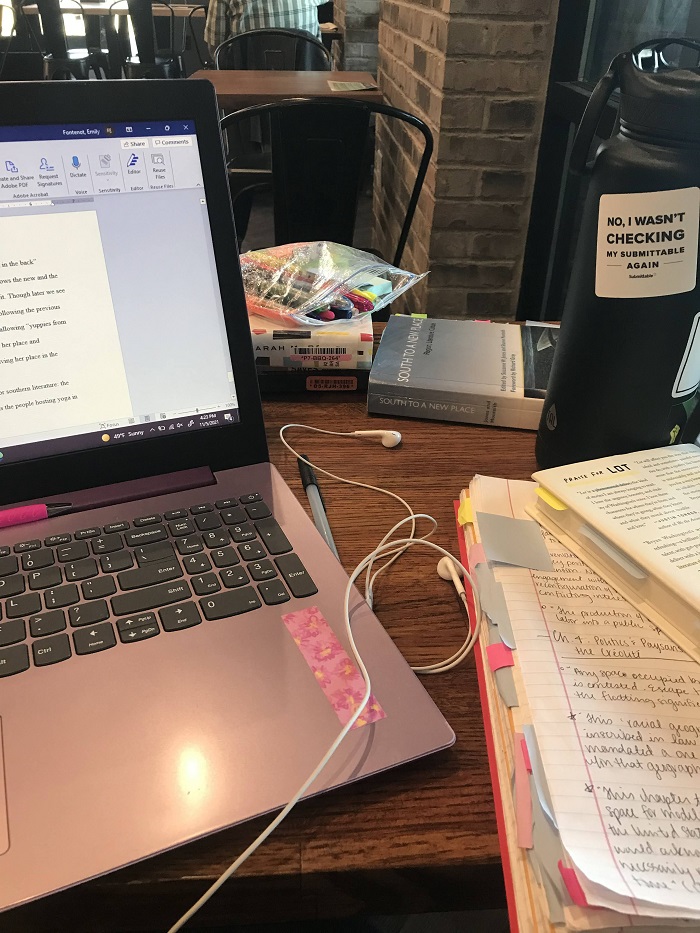
Narrative: A Cajun girl from south Louisiana, studying for and writing out her specialization exam for her PhD in English in a coffee bar in Bloomington, Illinois. My research focuses on the power of creative writing to dismantle monolithic ideas, particularly of the US south. Through the use of different literatures—fiction, memoir, creative nonfiction, criticism, poetry, and so many others—I study writers who attack head-on the nonexistent monolithic south. As I learn from and ponder on these writers and their work, my own fiction grows and adapts, doing its own resistance work which I hope to see out in the world someday. From the image and from the view of me doing this work, I may not seem to be the typical southerner one would expect, but as Ernest J. Gaines once told me, “We carry the south with us.”
Cooper Gibson, Sculpture and Expanded Media, What Miss Piggy and fried bologna have taught me
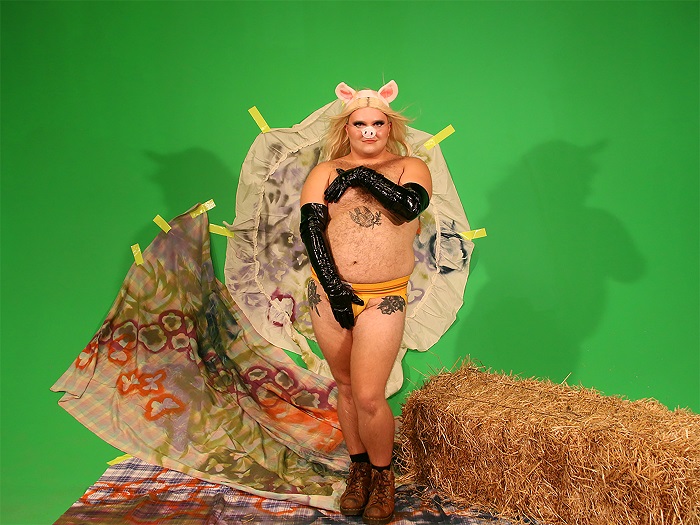
Narrative: My art engages with themes of sexuality, gender, class, and race. I am a gay and genderqueer person from south-central Kentucky. My research focuses on the intersections of these identities and how the multiplicity of my experience was shaped by the constructed landscape of the American south. My selected image is a staged film still made in conjunction with my video MISS PIGGY (MEAT TENDERIZER). I use the Muppets character Miss Piggy as a symbol of rural femininity and am contemplating her role as a queer icon. I am also investigating relationships between food and culture. As a kid I often ate fried bologna. This greasy and cheap southern dish is representative of poor and working-class folks. In my embodiment of Miss Piggy I challenge viewers ideas about sexuality, gender, and class. I am proud of where I come from and celebrate the beauty that I find there.
Rochele Gloor, Creative Technologies, Futureland in Blue
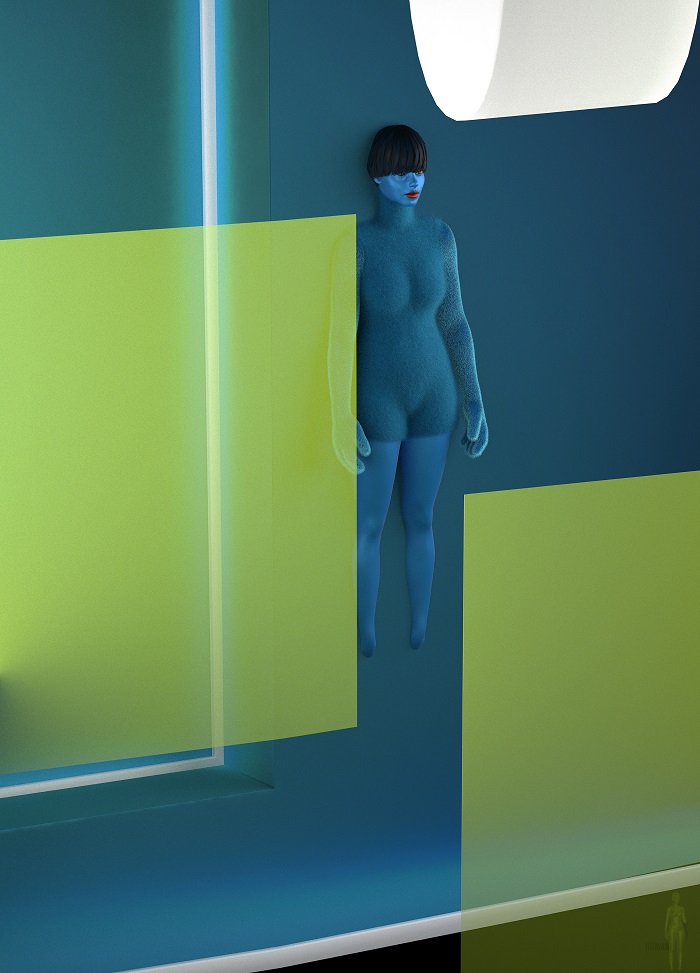
Narrative: Overproduction and overconsumption have driven the Earth to an extreme climate crisis. One of the major contributors is the fashion industry. Speculating future fashion scenarios utilizing digital technology is a part of my research on zero-waste and post-sustainable practices. I utilize a 3D design software, Clo3D, which was developed for creating “true-to-life” garment simulation in a virtual space before physical sampling and production. My research has led me to find artistic expression within this technology, as you can see in Futureland in Blue. A blue human with bunny fur arms mounted on a wall converses about social and environmental issues, transporting us to a future place. A place where humans are responsible, and the only waste is computer data. Through this artwork, I hope to bring awareness about the environmental impacts of clothing production and to educate about possibilities of digital technologies to lead us towards a balanced human-nature existence.
Nina Hanee Jang, English, Illuminating Heritage

Narrative: The architectural structure in the middle of this photograph is called “Bosingak,” an historical monument representing the values and beliefs of my country, South Korea. The surrounding buildings are architectural symbols signaling the influences of Westernization in Korea. In the midst of this cultural colonialism, Bosingak stands its ground with grace because her roots are deeply connected to her land even after multiple destructions and reconstructions.
While my dissertation focuses on Asian/Asian American childhoods in English literature, I always turn to my heritage. Analyzing narratives that center Asian American characters struggling with postcolonial/postwar forces, systemic racism, and discrimination against immigrants, my scholarly goal is connected to Bosingak’s meaning for our people, our resistance, and our empowerment amid forces that attempt to contain and control us. My research goal is to amplify the voices of Asian Americans and Pacific Islanders in American literature who deserves respect, care, and representations in American culture.
Elliot Lusk, Biological Sciences, Psychedelic Songbird Cerebellum
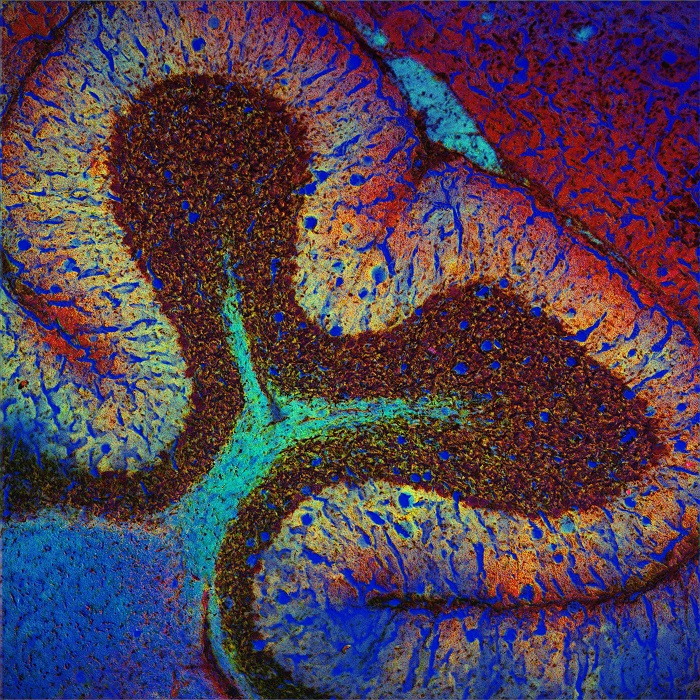
Narrative: Birdsong not only fills the world with beautiful natural melodies but is also a vital communication method for songbirds and is critical in their mate choice. Here we get a colorful look at a nestling European Starling (Sturnus vulgaris) brain. This 20-day old brain is full of rapidly growing and developing brain structures that the Starling will use to aid in the learning and production of song throughout its life. The first few months of life are a very developmentally sensitive time for the bird and a variety of stressors can interfere with brain regions in the song system during this time. My research examines how parasitic mites in bird nests early in their development might affect these brain regions and, in turn, affect song learning and production. The cerebellum, pictured here, has been linked to vocal timing of birdsong.
Special thanks to ISU Confocal Core for assistance in advanced bioimaging.
Elyse McCormick, Biological Sciences, Worse off together: consequences of microsporidian and virus co-infection for parasite dynamics and bumble bee host health
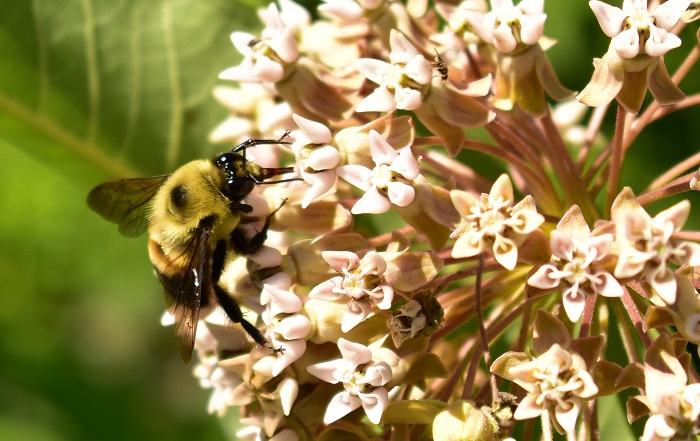
Narrative:Bumble bees face constant threat of disease whenever they dine; floral landscapes are full of various parasites deposited by other visitors. As such, bumble bees can be exposed to multiple parasites. My research focuses on how bumble bees respond when co-infected with two important parasites: a microsporidian parasite thought to cause bumble bee declines in the US and a virus that bumble bees catch from honeybees. I investigate how the coinfection influences bee health, including how infected they become and their survival, and how coinfection may affect how the parasites are passed on. I have found that the virus has a strong effect, resulting in decreased survival in both virus-only and coinfected bees. This demonstrates the importance of understanding how the mix of parasites that bees pick up as they go from flower to flower may have important consequences for their health and the ecosystem services they provide.
Sydney Metternich, Biological Sciences, Adaptation in Prairie Plants
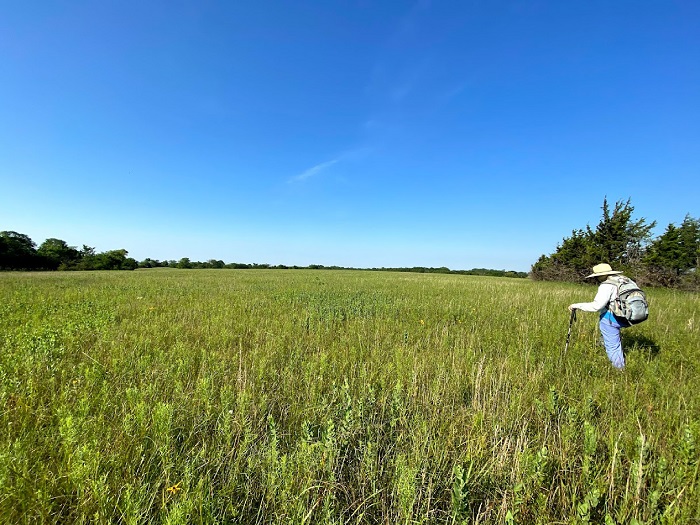
Narrative:The North American Tallgrass Prairie once spanned across the midwestern United States and was characterized by meadows of diverse flora and fauna with rich soil. Most of this ecosystem has been converted to agriculture and severely fragmented overtime. Though these prairies appear modest, they are teeming with soil microbial fungi working to structure plant communities from below the soil’s surface. These fungi can be beneficial or detrimental to plant species but are not yet well described. Our work explores the relationship between the prairie plant species, Lobelia spicata, and its soil microbial community in Illinois and Kansas prairies. Differences in precipitation throughout the Midwest influences the soil’s microbial diversity and subsequently local adaptation in vulnerable plant populations. Our research to better understand how plants respond to abiotic and biotic soil conditions has the potential to inform conservation and restoration efforts and to help maintain this captivating ecosystem.
Dani Park, Sociology, Schema of Double Consciousness”
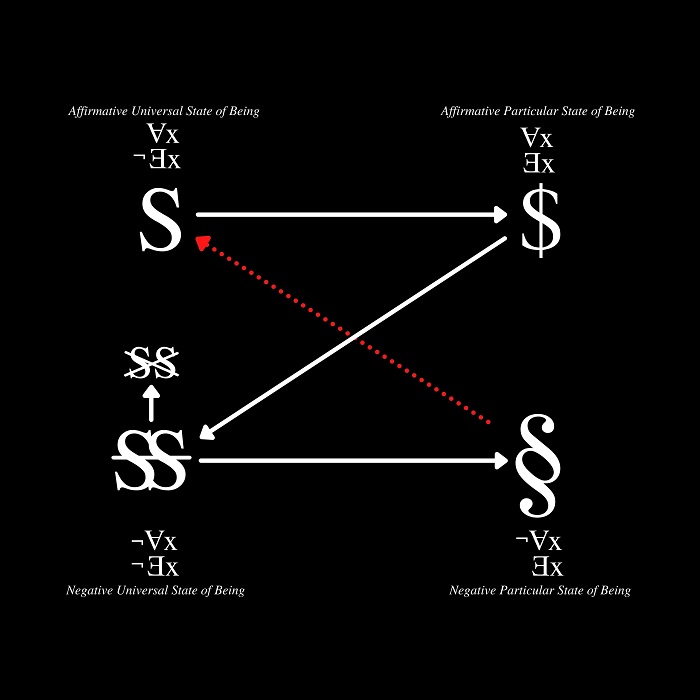
Narrative:As a person of color, one of my intellectual fascinations has always been W.E.B. Du Bois' notion of double consciousness, in which the oppressed, especially African Americans, face an internal conflict that divides identity in a way which the oppressors never have to experience. My particular interest in this topic focuses on double consciousness, but from a psycho-philosophical perspective. I argue that the Subject not only experiences double consciousness but undergoes it as a process that brings into question the very concept of existence and experience. Inspired by the French psychoanalyst Jacque Lacan, my image represents a graph in which the Subject (top left) begins the process of double consciousness, eventually undergoing division (top right) and finally ends as the separation of consciousnesses (bottom right). This conceptual schema is crucial in representing the processual nature of double consciousness and, more importantly, the inhumane degradation of those who undergo it.
Trevor Rickerd, Biological Sciences, Arabidopsis thaliana trichome
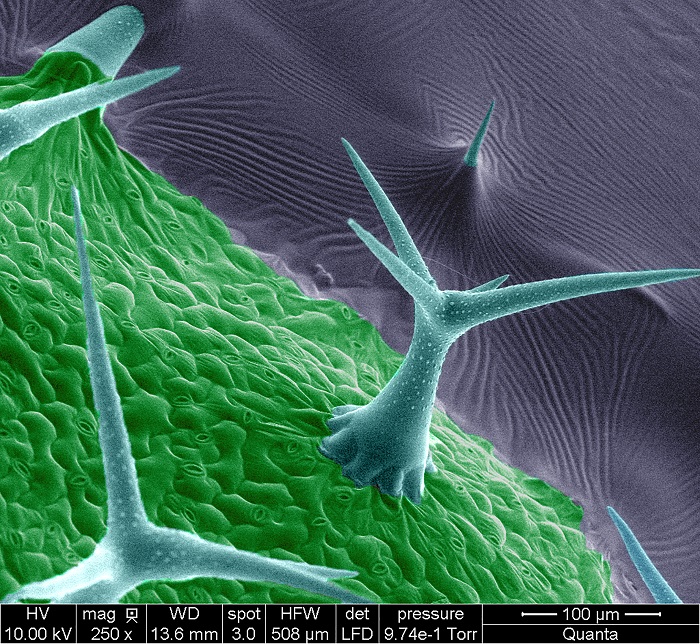
Narrative:The aerial organs of the Arabidopsis plant are covered with single-celled hairs called trichomes. These trichomes contain 3-4 branches and exhibit raised structures on their cell wall, called papillae. The composition and mechanism of formation of these trichome papillae are unknown though the presence of trichome papillae is observed to scatter incoming light and is theorized to be a means of photoprotection for the plant. Our laboratory studies a set of Arabidopsis mutants called glassy hair mutants, which exhibit trichomes that lack papillae structures on their cell wall and have a smooth surface. Our goal is to understand the underlying metabolic process leading to papillae formation on trichome cell walls. Using scanning electron microscopy, we can visualize the papillae on trichome cells (cyan) growing on a leaf (green). This image shows a wild-type trichome with papillae throughout the surface of its cell wall on a leaf embedded in cryo gel.
Caleb Sawe, Biological Sciences, Luci

Narrative:The “greenish mass” you see amidst many blue circles is a mammalian cell called “Luci.” The blue circles are nuclei of other cells. Luci is one of the lucky ones because she has been successfully transfected. Transfection is one of the methods used by scientists to take DNA from one organism and put it into another. DNA tells our cells how to make proteins like the motor protein I study in my lab. These motor proteins help move important cargo within our cells. Transfection is not always straightforward; not all cells accept foreign DNA. Out of hundreds of cells, only a few, like Luci, might get transfected. “Lucies” are important for my research because I can use these cells to study how different kinds of DNA make mammalian cells behave. Finding them, however, is like fishing in the deep blue sea.
Bethany Wohrley, Agrisciences, Worth Every Penny: Establishing Pennycress in Illinois Agricultural Systems
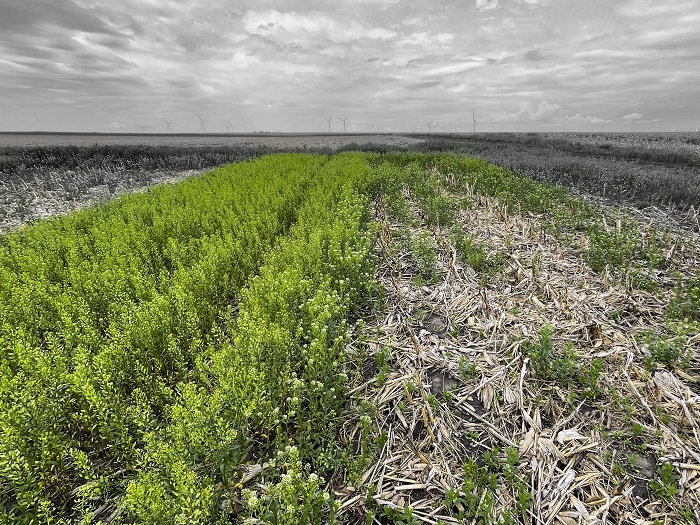
Narrative:Empty farm fields are a common sight in Illinois during the winter and contribute to environmental issues such as soil erosion and nutrient loss. Although cover crops can mitigate these effects, they are not widely used due to lack of direct economic return. Pennycress is a new cover crop that produces a marketable oilseed, which could incentivize more widespread cover crop use. Unfortunately, field conditions after corn harvest are challenging for pennycress growth. This image illustrates the visual contrast between full pennycress growth and limited pennycress growth due to the presence of leftover corn residue. My research evaluates management strategies that may improve pennycress growth such as breaking up leftover corn crop residues and using early-maturing corn hybrids. The successful implementation of pennycress into the current cropping system could lessen the environmental impact of agriculture, help source renewable fuels, and provide additional income for farmers.
Undergraduate Finalists and Winners
All finalists are displayed below.
Award Winners are:
- 1st Place ($200): “Unraveling the Consequences of Human Longevity” by Katelyn Tenuto (Psychology)
- 2nd Place ($150): “Protein Zoo” by Shaniya Barnett (Molecular and Cellular Biology)
Honorable Mention(s) ($50):
- “Refining Techniques for Assessing Best Management Practices for Nitrate Load Reduction by Comparing in Situ Tracers” by Joseph Hoberg (Geology)
- “Complete Evidence” by Sarah Patterson (Anthropology)
- “Priceless Prairies” Madison Steines (Conservation Biology)
People’s Choice Award ($100) in Graduate Category:
- “Priceless Prairies” Madison Steines (Conservation Biology)
Shaniya Barrett, Biological Sciences, Protein Zoo
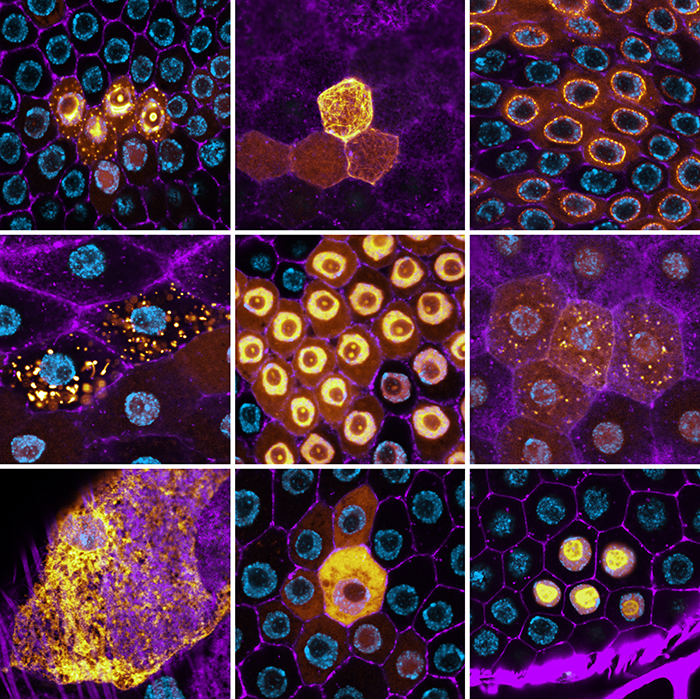
Narrative: Life arises from the orchestrated behaviors of thousands of different proteins in each cell. How each protein arrives at its correct location in the cell remains poorly understood. The Edwards Lab developed the "Hostile takeover" gene tagging system as a new approach to connecting protein structure, function, and localization, using the Drosophila (fruit fly) genetic model system. This montage of images, produced with ISU's spectral confocal microscope, shows protein localizations arising from 9 different randomly tagged genes expressed in clones of cells in a Drosophila cell sheet (ovary follicle cells). The fluorescently tagged protein fragments have each migrated to distinct locations including the cytoskeleton, nucleolus, vesicles, and nuclear envelope. The tagged protein is shown in orange/yellow, the actin cytoskeleton in purple, and DNA in blue. This project will bring new insights into mechanisms of cell organization
Cassidy Devine, Management, Adolescent Biophilia
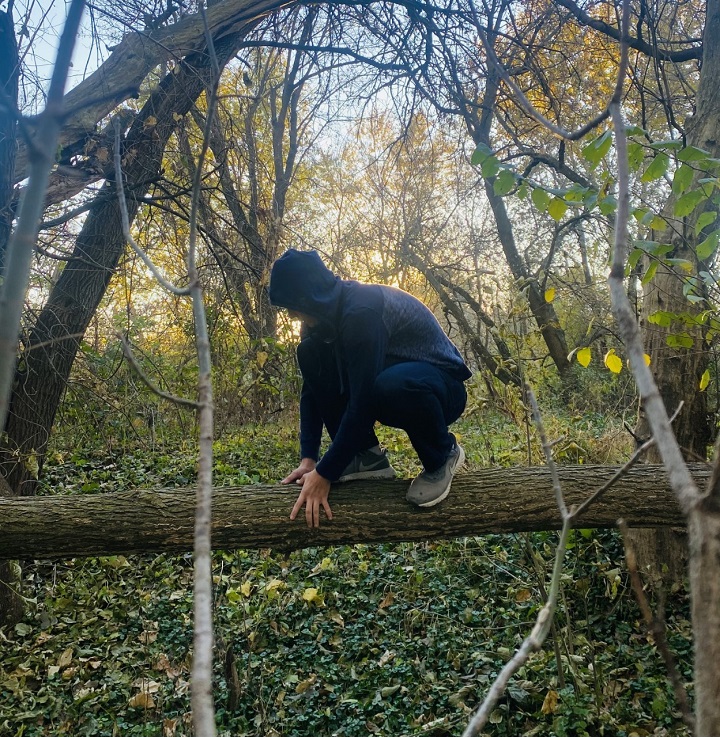
Narrative:We often think of ourselves as creatures of advanced practices. Now, more than ever, humans spend significantly more time indoors compared to our ancestors. Yet humans still feel a distinct connection to the earth. This is known as biophilia, or a person’s innate connection to the outdoors. My image captures primal instinct at its peak. When man is one with nature and gives in to the instinct to be fully in touch with the natural world. The photograph is designed to feel ominous, alluring, and powerful. As we gaze unto this moment, we ourselves can vicariously feel the connection between man and the biosphere.
Joseph Hoberg, Geology, Refining Techniques for Assessing Best Management Practices for Nitrate Load Reduction by Comparing In-Situ Tracers
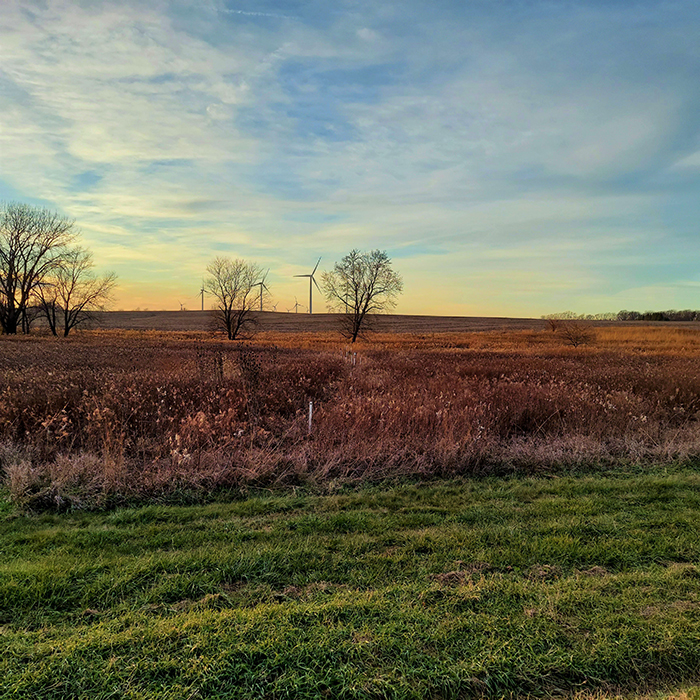
Narrative:The above image is a photo of site T3, a saturated buffer zone located downgradient from a crop field with installed subsurface groundwater drainage tiles and sampling wells (white PVC pipes) at various depths. T3 is the site of a long-term study in collaboration with the City of Bloomington to monitor groundwater quality and assess best management practices in reducing nitrate load in agricultural runoff, sourced from external fertilizers. Understanding nitrate movement in groundwater by means of a tracer test utilizing sodium chloride is a common practice; however, it is costly and difficult to distinguish the injected from preexisting chloride. Rhodamine WT dye (Rh) could be a cheaper more effective alternative, so I conduct a tracer test comparing NaCl and Rh at T3. Results suggest that Rh can be used as an effective tracer which opens a conversation of a new methodology. This image of T3 illustrates the practical, real-world application of my research.
Rendell Iguodala, Philosophy, Hunter’s Moon

Narrative:Curiosity about the universe and its origin has inspired humankind to express various beliefs about how it works.Earth’s inhabitants have insisted on ideations derived from the experience of existing and have historically claimed knowledge about the UNIVERSE.One claim has been that the UNIVERSE is DETERMINISTIC. In a DETERMINISTIC UNIVERSE, ALL EVENTS are said to be preceded by a CAUSE. When the Moon is visible in different shapes throughout a calendar year, humankind has claimed to discover the cause. When the Moon is FULL, humankind has claimed that the cause is from the SUN as it reflects light on one side of the Moon. As the Earth rotates, humankind says, Earth’s inhabitants experience different views of the Moon.
DJ Jelinek, Graphic Design and English, Percussive Maintenance / Generations in the Making
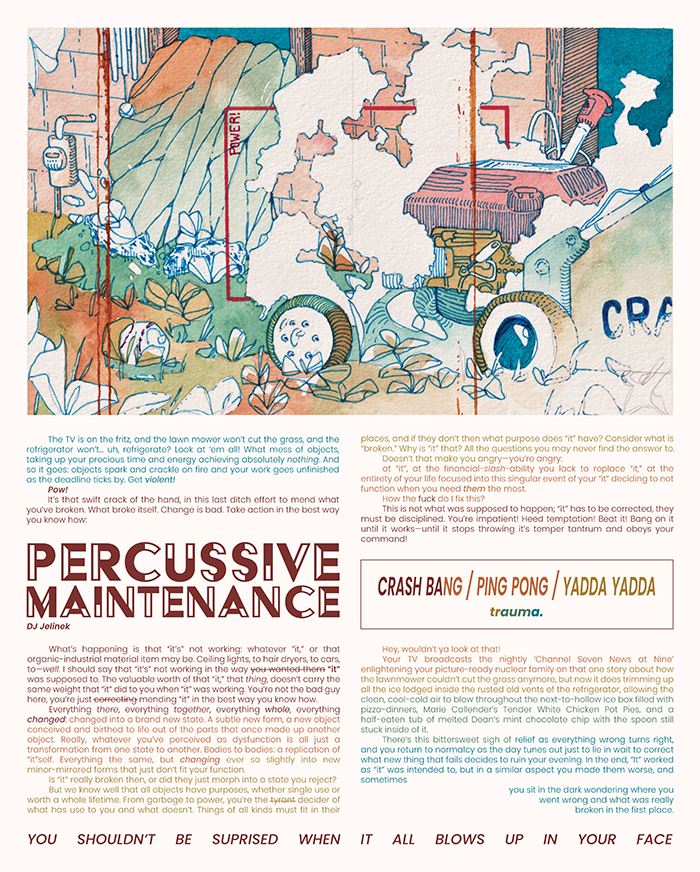
Narrative: I always thought writing, design, and artwork were three separate things. Yeah, so that's a lie. "Generations in the Making" is a watercolor print designed to replicate the overwhelming feelings I have toward the broken American nuclear family. Chaotic, disordered, and with a lovely contrast between nature and machine. It wasn't supposed to have a writing piece attached to it, but I can't help myself when this idea seeped its way into my writing. On the other hand, "Percussive Maintenance" is a prose/poetry piece centered around abuse in the household, and objectifying bodies for profit. This graphic poster was created to fuse these two together; a complimentary work to encompass the power of family trauma. I wanted to find a way to push traditional art, writing, and graphic design all into one composition. How can I make the best of my mediums and move them into one?
Awais Nadeem, Computer Science, Cross-Policy Compliance using Machine Learning & Artificial Intelligence
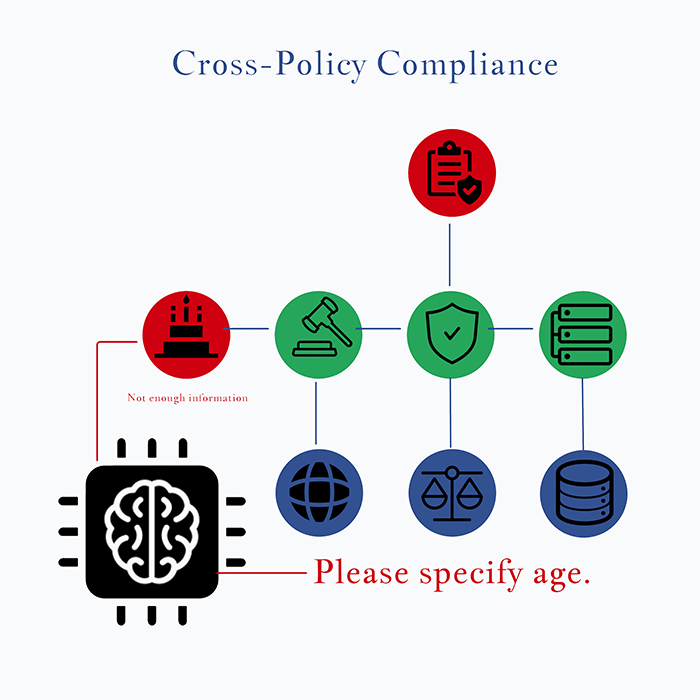
Narrative: My research topic is cross-policy compliance using machine learning. Policy compliance means classifying whether a policy “applies” to a given scenario, “does not apply”, or whether there is simply “not enough information.” The way machine learning models currently solve this problem is to utilize expression trees formed from policies. As the image shows, expression trees have several aspects that a model can utilize to classify a scenario. A model can classify a policy as “not enough information” due to one aspect, and completely discard all other relevant information in a scenario. This greatly limits the applications of the model. My research seeks to allow the model to determine the missing information and generate questions to fill the gaps. The result of my research would be a model that always determines “applies” or “does not apply” which will significantly increase the applications of machine learning for cross-policy compliance.
Usama Nadeem, Computer Science, Using Machine Learning to Aid Software Development
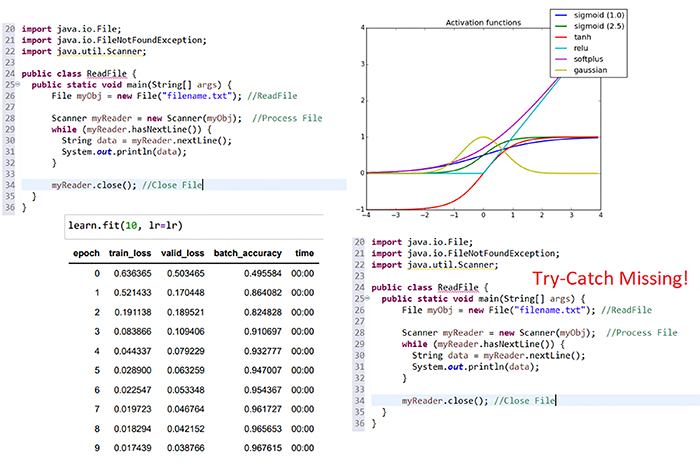
Narrative:Today, a lot of data is available in the form of raw unstructured data: Data without meaning. The field of machine learning takes such data, structures it, and uses it to produce meaningful models that can solve real-world problems. For example, today, most of the data collected comes in the form of text. Every day more than 18 billion pieces of textual data are generated across the globe, the overall meaning of which is simply impossible for humans to understand. This is where the need for machine learning architectures comes into play. Using natural language processing (NLP) architectures, we can train models on this data to ultimately perform various tasks, such as sentiment analysis, text generation, translation, etc. My research seeks to use such natural language processing models to expose software vulnerabilities within code. Ultimately, it is to prevent malicious agents from gaining access and performing unauthorized actions due to flaws in code left by software developers.
Sarah Patterson, Anthropology, Complete Evidence
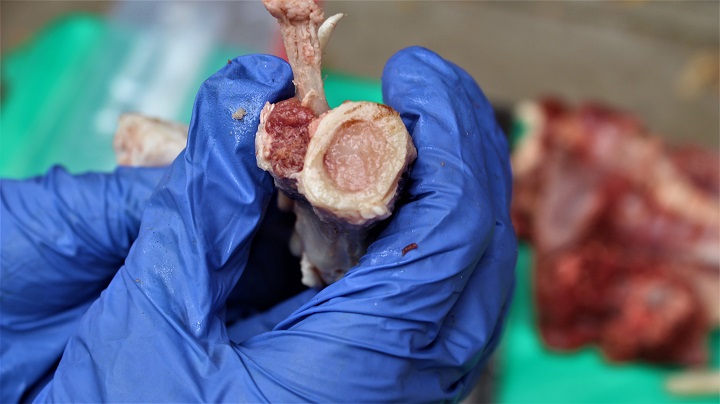
Narrative:This image is the encapsulation of all that I hope to find in my research. This project is a pilot study for my graduate thesis, in which I use the long bones of deer as human analogs for dismemberment by handsaw. I am replicating a study done by Dr. Steve Symes, a forensic anthropologist specializing in the different cut mark characteristics left behind by sharp trauma on human bone, and how those characteristics can be used as evidence in criminal cases. I am conducting a series of experiments in which I use handsaws of various blade types to make incomplete and, as you see here, complete cuts into bone so that I may match each saw to the cuts made via metric comparison. This image is taken just after making one complete cut through bone with a handsaw, so that the cross-section is visible. This image represents the complete pieces of evidence left behind by perpetrators during criminal dismemberment—the kind of evidence that could be used to bring justice to those who cannot speak.
Madison Steines, Biological Sciences, Priceless Prairies
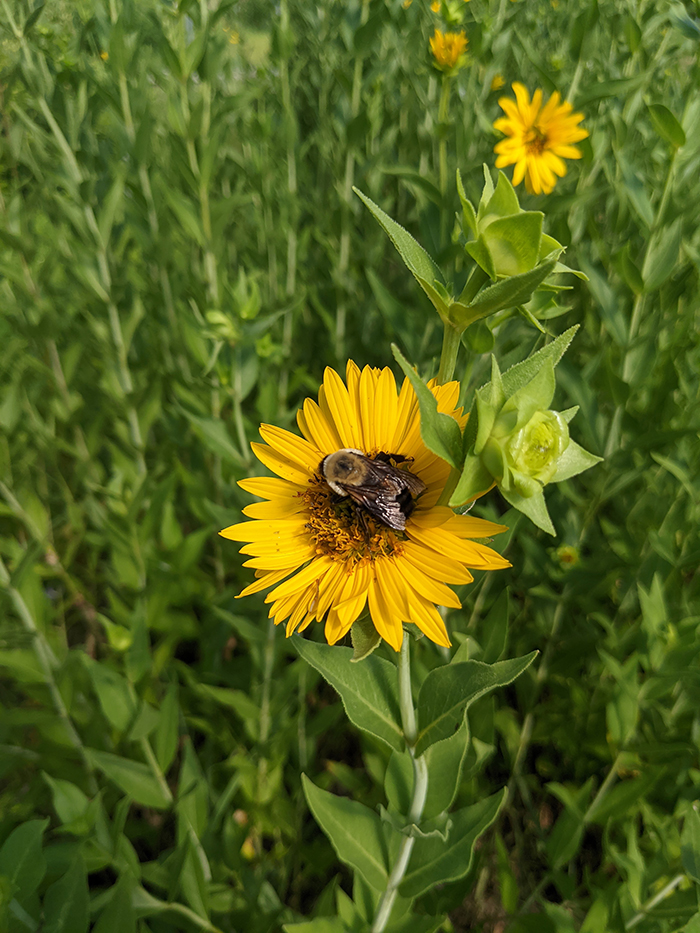
Narrative:This past summer I had the opportunity to participate in an NSF Research Experience for Undergrads here at ISU with Dr. Diane Byers. The focus of our research revolved around conservation and ecology of prairies in Illinois and Kansas, which are extremely threatened and important ecosystems of the Midwest. Our research examines how the precipitation gradient that exists between Kansas and Illinois affects the local adaptation of prairie species, including the rosinweed plant pictured here. My research was split between working in the lab washing and harvest sample prairie plants and working the horticultural center weeding and measuring plots. I was able to go into the field often, and even to several prairies around ISU and some in Kansas, which is where this image came from. I learned a lot more about the importance of prairies throughout the summer and will be continuing to work with Dr. Byers through my senior year.
Katelyn Tenuto, Psychology, Unraveling the Consequence of Human Longevity
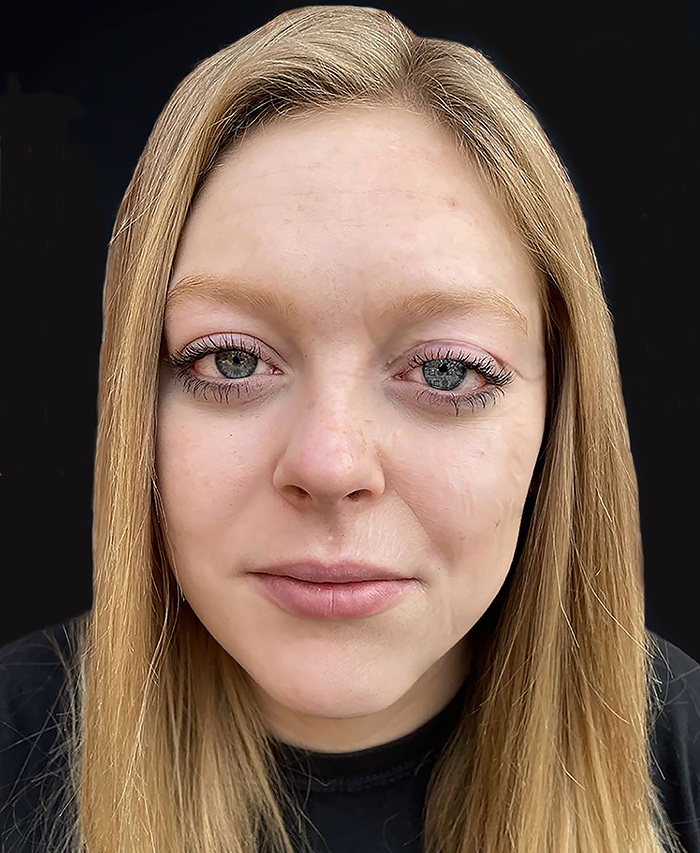
Narrative:As humans are living longer, the presence of cancer is skyrocketing, and it is our responsibility to be proactive. This image represents a curiosity to learn about one’s family genetic history as they age and as their risk for cancer increases. The reflection of the family tree in the eye symbolizes the importance of looking ahead before disease approaches. I am researching how our evolutionary and lifespan changes are contributing to the rise of cancer in our society. As the human lifespan has increased, we are seeing an increase in certain types of cancer such as melanoma, liver cancer, and breast cancer. With age, cells become more damaged and cancer-initiating cells collectively rise. I aim to use my research to highlight the importance of genetic testing and how we can educate ourselves and others about this destructive disease and how we can understand these evolutionary changes to benefit our health.